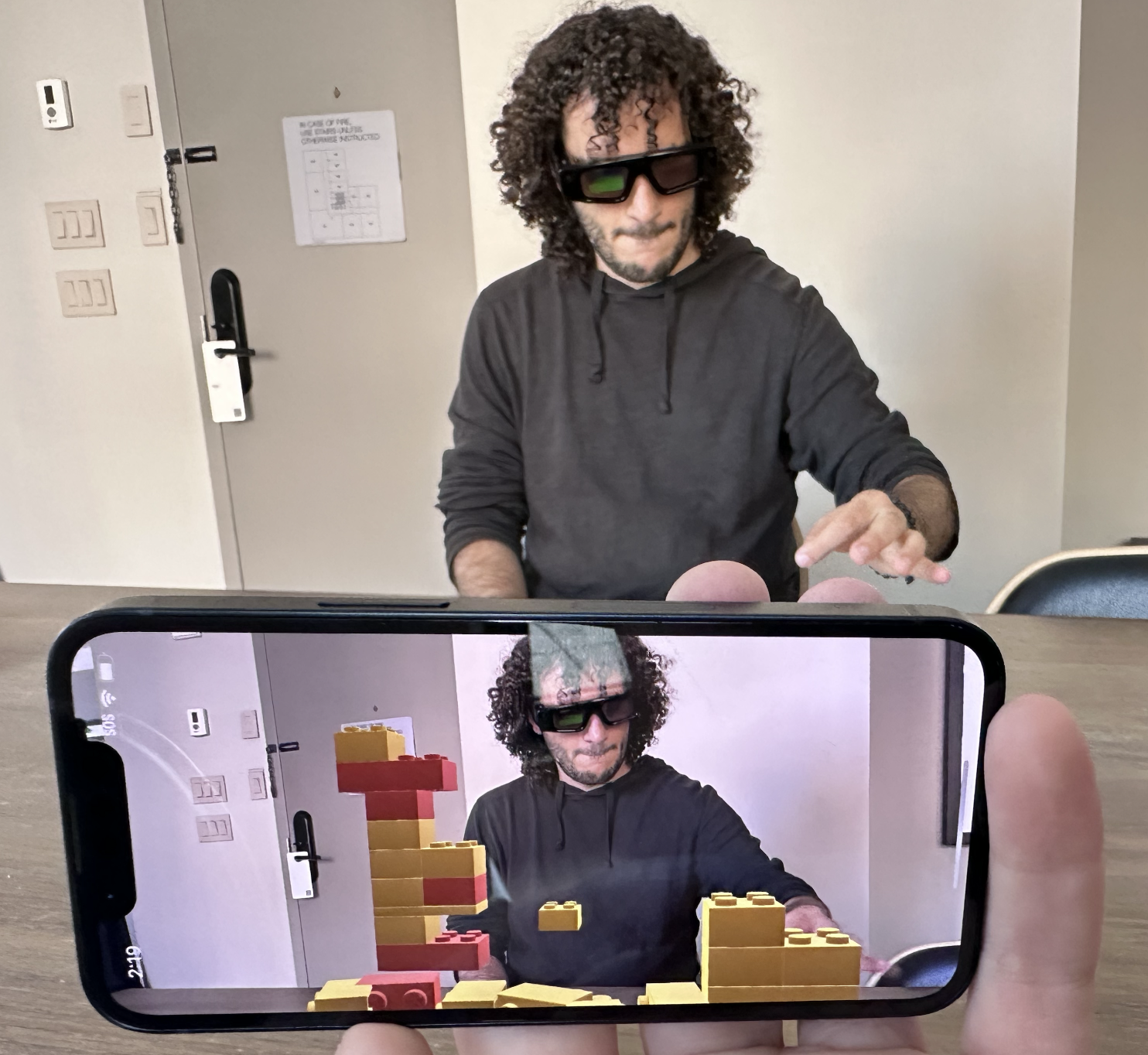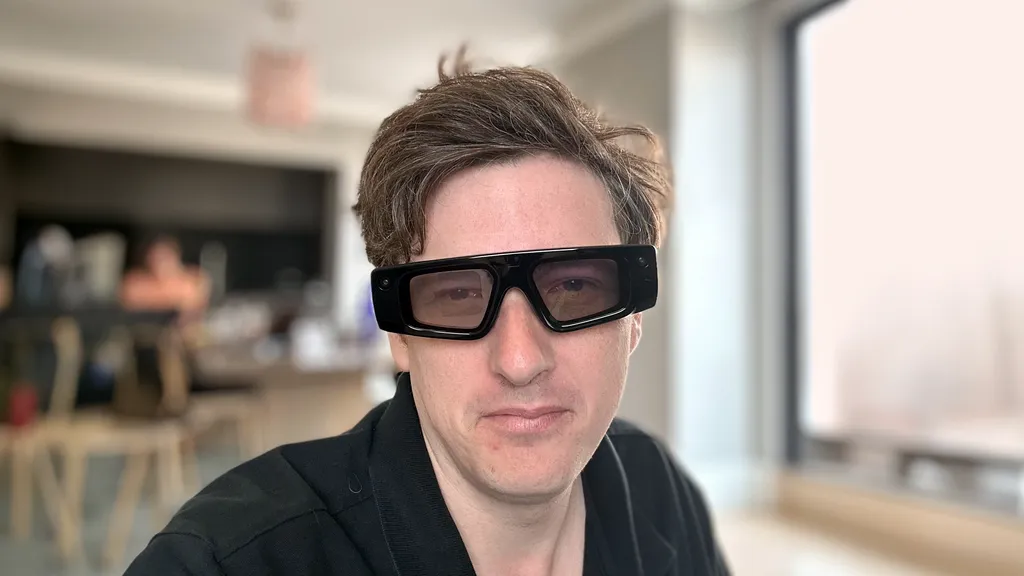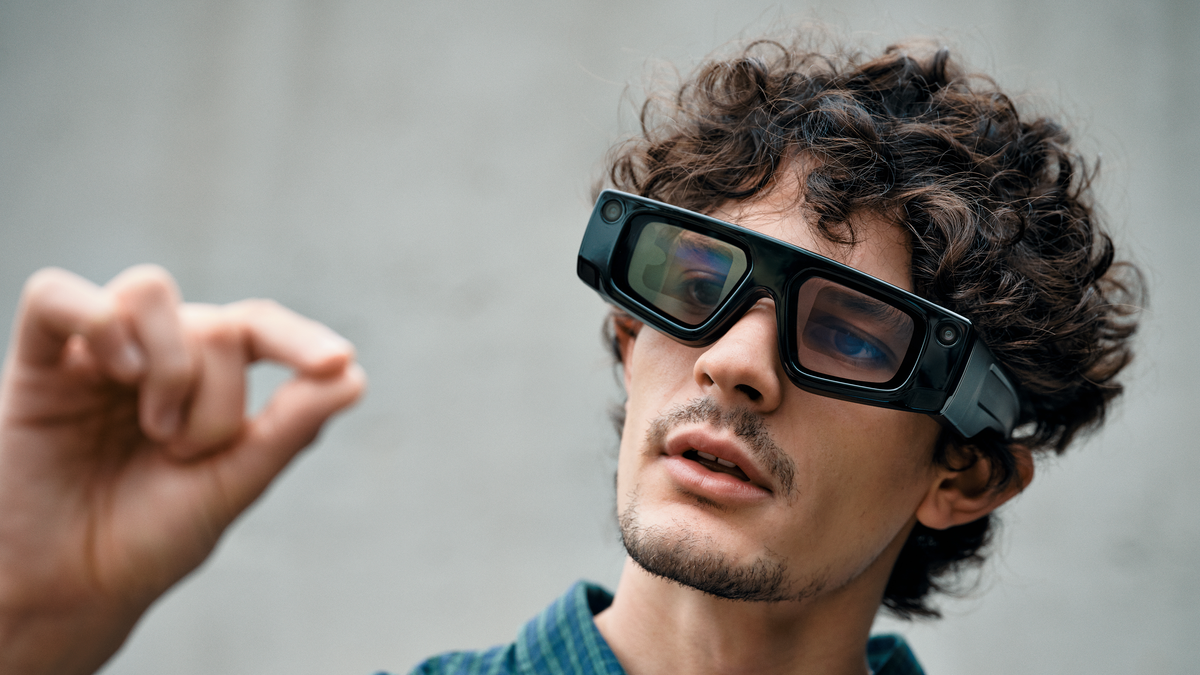Niantic's Peridot is a standout example of what Snap's new AR Spectacles can do.
Niantic applied an important bit of video game interface. When your friend is out of view, the glasses show a dotted line arcing off to the side of the glasses to indicate the creature's location.
To walk confidently from indoors through a doorway I've never crossed before is something that's still rather uncomfortable even on the Meta Quest 3 or Apple Vision Pro passthrough systems. Imagine a small metal lip on a sliding glass doorway you need to step over onto an outdoor landing at a slightly different height to ground level. Such a step might be quickly navigable to a pair of unaided healthy eyeballs, but it would actually be a major obstruction even in today's most advanced consumer VR headsets due to the limitations of their passthrough reconstructions.
Snap's Spectacles are see-through, though, and I did immediately cross that threshold without a second thought with the glasses automatically changing their shading and my Peridot's arc following me out into the open sunlight and warm air outside.
I've tried all generations of HoloLens and Magic Leap and have vague memories in my head of portals opening on the walls and characters constantly darting off the sides of the headsets. Here, though, I have a much clearer image in my head of a friendly little Peridot sitting in front of me on the ground because of Niantic and Snap's careful design work with these glasses. Altogether, considering weight reduction compared to the quality of the experience and wide field of view, I'd call this the best see-through AR demo I've ever seen and proof that there's consumer use for the medium in the near future even without the vastly superior field of view of VR headsets.
Snap also showed me glimpses of a slick app for managing its latest generation Spectacles and the software seemed more fully featured and easier to use than either of Meta's own Horizon or View apps. Using it, for example, to look in on a Lego-building session in a nearby set of glasses worked so effortlessly that it seems awkward not to have it work that well on any other system. The Lego were roughly Duplo-sized, but manipulating them and snapping them together with hand tracking worked reasonably well.

Another highlight of my demo turned a phone into a fully tracked 6DoF object – I stood and putted a couple balls 1:1 as if I was holding a club in my hand and it was all entirely usable.
Beyond these highlights, the Spectacles still had some rough edges, some of which might be improved in future software updates. I noticed some drift to the glasses' understanding of my world – rendering virtual objects onto geometry offset with the physical position it is meant to overlay. Over time, or by moving closer, the glasses would seem to correct the offset. The glasses would also occasionally struggle to display virtual content through fast movements, but would also recover fast.
Imagine yourself walking the streets of New York when you see a small purple creature climbing along the side of the buildings on the other side of the street. As your eyes focus on the street underneath the Peridot, you can see a person in another pair of the thick-rimmed Spectacles walking along the street over there. You've just encountered your first Peridot in the wild, and you just made your first social AR interaction.
Can Snap turn its $100 per month kit into a consumer product? I don't know, but Snap's Spectacles and Niantic's Peridot show the necessary pieces to enable this type of interaction for the very first time.
Pokemon In AR Glasses & VR Headsets
Snap's Spectacles and Pokemon Go creator Niantic appear to have everything they need for a Pikachu to follow you around as your companion and get you into battles with random trainers. When will this happen? That's still extremely difficult to predict.
Pokemon Go has seen years of software updates to add warnings and map changes that keep its players journeying through the physical world safely without interference. While see-through AR glasses like Spectacles are still comparatively limited by field of view in what can be shown beyond a small digital creature, the design space is still a huge opportunity for creatives and players themselves. Just how much of ourselves do we want to put into the behavior and decoration of a virtual pet? This is a great question that people can find out by iterating with Spectacles today.

For now, designers cleverly cut off the head of the gigantic Pokemon Exeggutor in the mobile screenshot above to convey its extreme height. In any AR glasses at almost any distance, seeing a 10-meter-tall Exeggutor foot to head is not going to be possible for a very long time still. In VR headsets, though, the field of view starts off much wider and the outside world is blacked out at the periphery. This makes VR headsets ideal for deep interactions with large characters that play out across entire digital environments.
It's going to be a very long time before creatures of Exeggutor's size can do battle with one another in mixed reality in the physical world without major sacrifices being made to mechanics that hide the limits of the field of view and tracking technology. By that same token, though, finding ways across both VR headsets and AR glasses to minimize those sacrifices and make a truly believable and lovable virtual pet – as seen with Peridot on both Spectacles and Quest 3 – seems within reach across both types of eyewear.
































